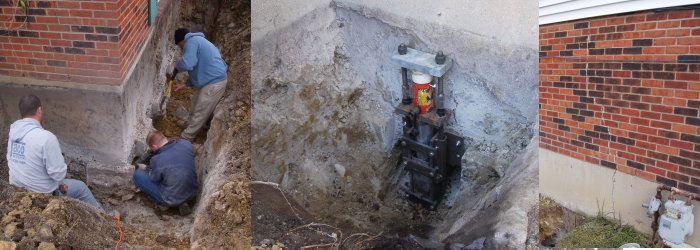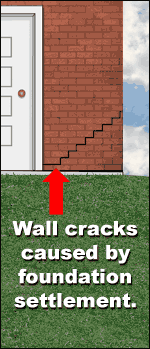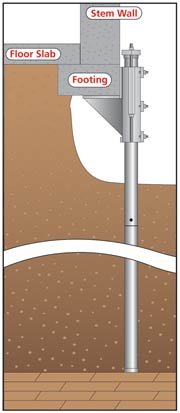

Dayton Foundation Stabilization & Piering
Jaco Waterproofing has a trained and professional staff that can repair your unstable foundation. Don't let the situation get worse by not doing anything. Call Jaco to get a free estimate on the solution to your problem. Once the work is done your can rest assured that the job is done right the first time.
A Company You Can Trust
For over 30 years we have been repairing, waterproofing and stabilizing foundations. We are members of Angie's List and the Better Business Bureau. Let us show you how our excellent staff will repair your home.
Cincinnati Foundation Piering

Foundation movement may result from a wide range of factors, which can include:
- Shrinking or swelling of clays caused by changes in moisture content
- Compression of a soft layer in the ground as a result of the applied foundation loads
- Soil softening
- Frost heave
- Improper back filling
- Variation in groundwater levels
- Erosion
- Vibration from nearby construction
- Hydrostatic Pressure
Jaco Waterproofing installs pre-engineered helical and steel piles to stabilize and lift sinking foundations.
Signs of Foundation Failure

Inside of House
- Cracks in drywall or ceilings
- Sticking windows and doors
- Cracks in concrete floors
- Gaps around door and windows
- Misaligned doors and windows
- Sloped floors
Outside of House
- Gaps around doors and windows
- Cracks in foundation
- Stair step racks in brick mortar
- Fascia board pulling away
- Chimneys are tilting or leaning
- Water ponding around the foundation
- Soil separation around the foundation
Garage
- Separation cracks between the floor and walls
- Walls rotating outward
- Slopping floors
Basement
- Walls leaning in or out
- Bowed walls
- Cracks in the poured or block walls
- Water leakage through cracks at base of walls
- Cracked floors
- Seal plate separation
- Water stains on floors and walls
Crawl Space
- Cracks in the foundation
- Bowing walls
- Tilting or leaning walls
What Causes Foundation Settling

1. Weak Bearing Soils
Some soils cannot support the weight of the building. The footings cannot spread the weight and properly and this causes the foundation to settle and sink into the ground. If the settling rate is uneven, the foundation can crack.
2. Poor Compaction
This leads to weak bearing soils. Developments are typically made by leveling uneven ground. The high areas are pushed into the low lying areas. This soil must be properly compacted. If not, the soils may not be able to support the building.
3. Changes in Moisture Content and Freezing
Clay soils are very susceptible to changes in the moisture content. High levels of soil moisture such as spring and winter cause the soil to expand and rise. Or it can be so wet that the soil loses the ability to support the structure. Think of yourself sinking in mud.
Similarly, dry periods such as summer and fall can cause the soils to lose volume and shrink. This can cause the foundation to drop and settle.
Related to this is frost heave caused by extremely cold winters. If the soil freezes below a foundation or crawl space footing ,this can raise the foundation and crack it.
4. Mature Trees
Mature trees can demand large amounts of water during the day. They suck water out of the soil and during periods of drought, the can dry out the ground below and around your home. This dries out the soil and the ground level drops. And with the soil goes the foundation and cracks may develop.
Home Improvement Financing
Need financing for your home improvement project? Click Here.
Steel Pier Lifting

Steel piers
Steel piers are an excellent choice for most foundation repair issues which are either caused by organic soils, swelling clays, poor compaction, improper footer embedment, and erosion or run off. Steel piers, also know as push piers, mini-piles or resistance piers are an economical and permanent solution for your home. Steel piers are an end bearing pier that does not rely on the soils skin friction to provide support. These underpinning piers are able to develop a factor of safety due to the fact that they are individually load test during installation.
The Steel Pier underpinning products are driven hydraulically into the soil, lifting the structure's foundation, then the top bracket is capped - permanently holding the structure in place.
Read MoreHelical Pier Lifting

Helical Piers
Helical piers have been in use for the stabilization of foundations since the early 1800's. The original helical pier was designed as a wooden shaft with an iron helix for use in lighthouse foundations. Helical piers have the capacity and in certain soils the advantages to support your home for years to come. They are quick to install and are an excellent choice for foundation repair and stabilization where limestone and/or load bearing strata are not easily accessible.
Helical piles or piers can also be used in new home construction in the place of old fashioned concrete piers. They offer an economical choice of underpinning and allow for tight construction schedules to be kept.
Helical Torque Anchors
These screw pile products are driven into the soil with hydraulic torque motors and can be used to raise an existing foundation or in new construction to prevent foundation settling.






